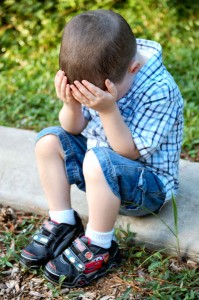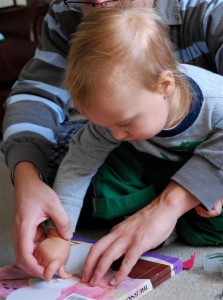 Hypothetically speaking, let’s pretend there is a parenting practice with the following attributes:
Hypothetically speaking, let’s pretend there is a parenting practice with the following attributes:
- while it usually results in immediate compliance, it is generally ineffective in modifying longer-term behavior (it is even ineffective from hour to hour or day to day);
- it causes strain on the parent/child relationship; and
- it can only be used for a few years of the child’s life, outside of those few years it is totally ineffective and/or inappropriate.
What, exactly, is attractive about that? Yes, there is that immediate compliance, but if the parenting practice doesn’t even result in changed behavior an hour later, why waste the effort?
Why not try something that actually works?
Part of the post “Undermining General Beliefs About Corporal Punishment” has stuck with me since I read it during the Carnival of Gentle Discipline. In the post, the author discussed the arbitrary lines drawn between “spanking” and “abuse,” as well as the rationales given for corporal punishment.
The part I keep coming back to is the general consensus that there is an age range in which it is “appropriate” to spank. According to the “experts” (and the spanking parents who discuss these things online), you should not spank babies younger than about 15-18 months, and you should not spank children past the age of 7 years. (1)
If you know that the “solution” of spanking is only a short-term “fix,” why do it at all? If spanking is one of your parenting tools, you will eventually have to toss it out of your toolbox. What will you do after it is no longer appropriate to threaten your child physically?
How will you relate to your kids when the threat of spanking no longer hangs over their heads?
Even if we ignore the many negative long-term effects of spanking, it simply makes no sense to rely on a method of discipline that will only work for a few short years. “Lasting authority cannot be based on fear[,]” so where will your authority lie after your children no longer fear your hand or your belt? (2)
Instead of creating a parent/child relationship based on fear and mistrust – as spanking often does – it is healthier and more effective in the long run to create a relationship based on trust and respect. Gentle discipline and playful parenting techniques are healthy and effective tools that work from toddlerhood through the teenage years.
What’s more, those few years that parents are “allowed” to spank are also the years that our children are forming lasting mental impressions of us.
Would you rather your child form an impression of trust, or of fear?
_______________________
(1) I choose not to link to any of these “experts” or discussion boards because I do not want to contribute to their traffic/Pagerank. If you’re interested, I’m sure you can find several sites to this effect on Google.
(2) Ask Dr. Sears, “10 Reasons Not to Hit Your Child”

 In Part 1 of this two part
In Part 1 of this two part  But for the most part, we’ve not had to deal with “typical” toddler tantrums. By typical, I mean the ones harried veteran parents always stop to warn you about when they see you cuddling a sweet, drool-soaked little bundle of baby chub in the supermarket. And you would smile and nod sympathetically, edging closer to the clerk (because the parent’s wild eyes and twitchy left nostril are making you nervous) all the while knowing that your child will never be “typical.”
But for the most part, we’ve not had to deal with “typical” toddler tantrums. By typical, I mean the ones harried veteran parents always stop to warn you about when they see you cuddling a sweet, drool-soaked little bundle of baby chub in the supermarket. And you would smile and nod sympathetically, edging closer to the clerk (because the parent’s wild eyes and twitchy left nostril are making you nervous) all the while knowing that your child will never be “typical.”
 Many parents (myself included) are under the impression that the moment we are born into the world of parenting, our own needs and desires become secondary. That is true to an extent: parents do not make up the bulk of the nightlife scene, we often have to yield the bathroom to littler bodies, and we have less time to leisurely read the newspaper or go backpacking when children are around.
Many parents (myself included) are under the impression that the moment we are born into the world of parenting, our own needs and desires become secondary. That is true to an extent: parents do not make up the bulk of the nightlife scene, we often have to yield the bathroom to littler bodies, and we have less time to leisurely read the newspaper or go backpacking when children are around. Let’s be honest: toddlers and young preschoolers can wear on even the most patient person’s nerves. From the constant questions (“why?” “wat dat?” “where mama go?”) to the wild mood swings and outbursts,
Let’s be honest: toddlers and young preschoolers can wear on even the most patient person’s nerves. From the constant questions (“why?” “wat dat?” “where mama go?”) to the wild mood swings and outbursts,  important they are to you. Give them affection without limit, without reservations, and without excuse. Pay as much attention to them as you can, regardless of mood or circumstance. Let them know you’re delighted to be with them, that you care about them no matter what happens. This basic posture is completely different from praise, which is doled out as a response to something a child does.
important they are to you. Give them affection without limit, without reservations, and without excuse. Pay as much attention to them as you can, regardless of mood or circumstance. Let them know you’re delighted to be with them, that you care about them no matter what happens. This basic posture is completely different from praise, which is doled out as a response to something a child does.